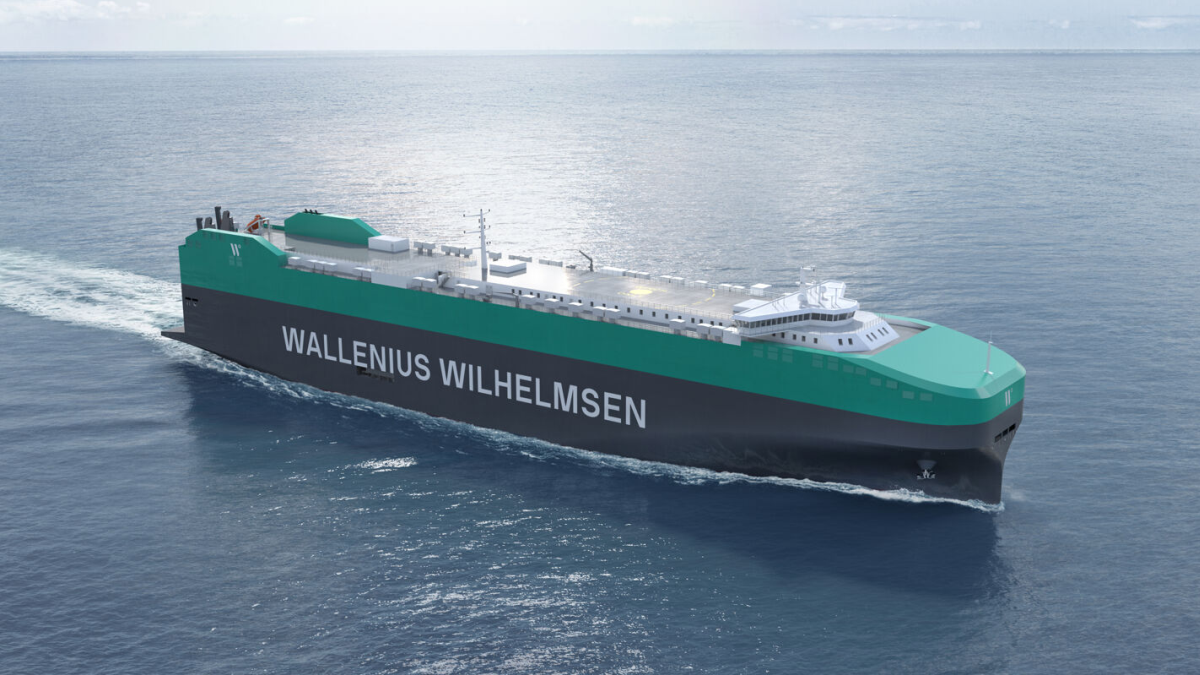Norwegian car carrier operator Wallenius Wilhelmsen is adjusting the fuel plans for 14 newly built PCTCs. The announcement was made at the company’s second quarter 2025 earnings conference call, with the aim of diversifying fuel supplies and preparing for the future use of sustainable fuels such as ammonia.

Specifically, Wallenius Wilhelmsen will adjust the fuel scheme of the 14 “Shaper” class methanol dual-fuel PCTCs built by China Merchants Jinling Shipyard (Nanjing) Co. Ltd.(“CMJL (Nanjing)”): 7 PCTCs will be equipped with liquefied natural gas (LNG) dual-fuel engines, and 7 PCTCs will be equipped with methanol dual-fuel engines. The 7 new PCTCs using LNG fuel will be equipped with fuel tanks that can store ammonia (ammonia-ready design).
The delivery schedule for the 14 Shaper-class PCTCs remains unchanged, with delivery scheduled between 2026 and 2028. Through this new shipbuilding program, Wallenius Wilhelmsen will be able to procure all types of conventional fuels, including bio-based and electricity-based fuels such as methanol and ammonia.
The adjustment will cost approximately US$80 million, which means the cost of each PCTC will increase by approximately US$11.42 million. According to data released by Wallenius Wilhelmsen, the company has already paid a total of US$43 mill a toion in installments to CMJL (Nanjing).
Wallenius Wilhelmsen and CMJL (Nanjing) signed a contract in October 2023 for 4+4+4 9,300 CEU methanol dual-fuel PCTCs. On February 27, 2024, Wallenius Wilhelmsen announced the contracting of the first four option vessels, scheduled for delivery between May and November 2027. On March 26, the two parties signed an option agreement for four additional vessels. On May 24, the contracting of four additional options came into effect, bringing the total order to 12+4 9,300 CEU PCTCs. On September 25, the contracting company announced the upgrade of the four 9,300 CEU PCTCs contracted by CMJL (Nanjing) to 11,700 CEU capacity. On November 8, the contracting company announced the exercise of an option for two 11,700 CEU “Shaper”-class PCTCs, also upgrading two 9,300 CEU PCTCs to 11,700 CEU capacity.
To date, Wallenius Wilhelmsen has confirmed 14 PCTCs in CMJL (Nanjing), including eight 11,700 CEU PCTCs and six 9,300 CEU PCTCs. In addition, Wallenius Wilhelmsen has two option vessels in CMJL (Nanjing), which will be confirmed before the second half of 2025.
It’s worth noting that according to the latest design contract announced by ship design firm Deltamarin, the vehicle loading capacity of the 11,700 CEU PCTC ordered by Wallenius Wilhelmsen has been further increased to 12,100 vehicles. According to previously released details, this world’s largest PCTC is approximately 234 meters long and 40 meters wide, with 14 car loading decks (including four movable decks). While achieving maximum loading capacity, it also features a tailgate with a maximum load capacity of 480 tons, enabling the loading of oversized and overweight ro-ro cargo.
Wallenius Wilhelmsen maneuvered steadily through the second quarter with an EBITDA of USD 472m.Total revenue for Q2 was USD 1,350 million, an increase of four percent quarter over quarter due to strong volumes for the shipping segment. The EBITDA for Q2 of USD 472m is an increase of two percent quarter over quarter, mainly driven by the shipping segment.
Net profit for the period totaled USD 403 million with USD 135 million explained by a capital gain following the sale of the MIRRAT terminal. Without the sales gain, net profit for the period would have been USD 268 million, up eight percent QoQ.
During the reporting period, Wallenius Wilhelmsen secured new contracts worth approximately USD 500 million, with a total backlog of shipping service contracts reaching USD 8.7 billion and a total backlog of logistics service contracts reaching USD 3.1 billion. The weighted average contract terms were 3.6 years and 7.8 years, respectively.
According to its official website, Wallenius Wilhelmsen manages a fleet of 127 vessels covering 15 trade routes and is a leading global provider of sea and land transportation services for automobiles and heavy ro-ro equipment. The company’s business covers 28 countries and regions, with approximately 12,000 employees across all business segments.


